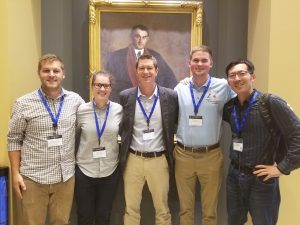ABL and Collaborators Receive 2 New NIH Grants!
The UNC/NCSU Applied Biomechanics Laboratory, in a great example of the inter-disciplinary nature of biomedical engineering and the impact of collaborative science, was recently awarded two new research grants from the National Institutes of Health.
First, in collaboration with the UNC Division of Geriatrics and Co-PI Dr. Gregory Sawicki in the Georgia W. Woodruff School of Mechanical Engineering at Georgia Tech, we will begin work on a new five-year NIH R01 to study (1) neuromechanical explanations for the greater metabolic energy cost of walking in older adults and (2) translation of that understanding to biologically-inspired wearable robotics for preserving independent mobility in our aging population. Ultimately, we hope to use ultrasound imaging to guide optimal prescription of assistive devices to improve locomotor function in aging – an outcome that will have significant positive impact on quality of life for millions.
Second, in collaboration with Co-PI Dr. Brian Pietrosimone in the UNC Department of Exercise and Sport Science, we will begin work on a new NIH R21 to study how altered lower extremity loading affects knee joint biomechanics, joint tissue biochemistry, cartilage deformation, and quadriceps muscle contractile behavior during walking in people following ACL reconstruction. By combining real-time biofeedback, ultrasound imaging, and biochemical markers, this study will be the first to determine the acute effects of joint loading on a collection of critical factors associated with the pathogenesis of post-traumatic osteoarthritis in a relevant patient population.
We are incredibly excited to continue our work with these exceptional groups of colleagues and collaborators.

 Thompson JD, Plummer P, Franz JR. Age and falls history effects on antagonist leg muscle coactivation during walking with balance perturbations. Clinical Biomechanics.
Thompson JD, Plummer P, Franz JR. Age and falls history effects on antagonist leg muscle coactivation during walking with balance perturbations. Clinical Biomechanics.




 Rasske K and Franz JR. Aging effects on the Achilles tendon moment arm during walking. Journal of Biomechanics (In press).
Rasske K and Franz JR. Aging effects on the Achilles tendon moment arm during walking. Journal of Biomechanics (In press).